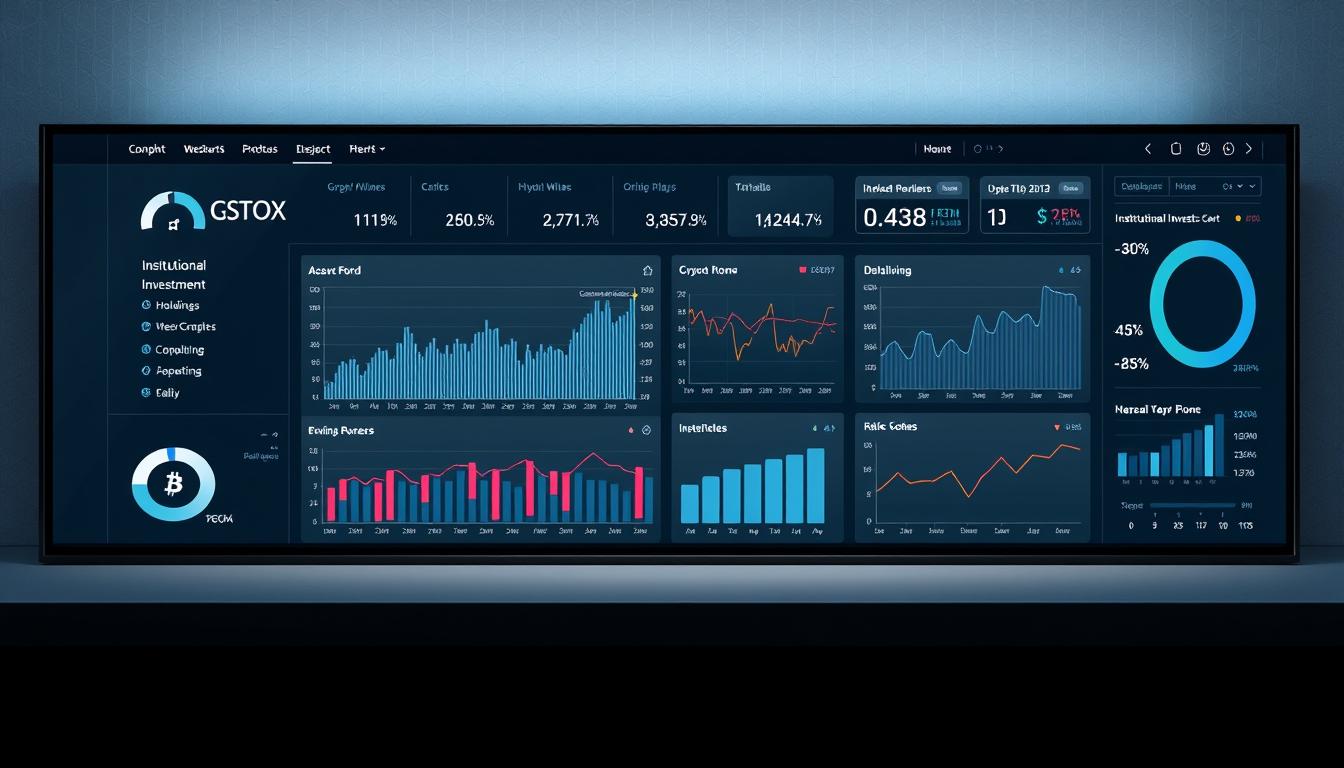Institutional investment in digital assets skyrocketed 387% from 2023 to 2025, according to BlackRock reports. This isn’t about retail traders anymore. We’re seeing pension funds, sovereign wealth funds, and major banks enter the market.
2026 marks a turning point in the crypto space. The infrastructure is now in place. We have real regulatory frameworks, legitimate custody solutions, and technology that works at scale.
The cryptocurrency trends of 2026 signal a fundamental shift in financial systems. Crypto market analysis reveals patterns of lasting change, not just temporary speculation. The industry has matured beyond its wild west phase.
We’re witnessing the emergence of a more substantial and practical cryptocurrency ecosystem. This new era focuses on real-world applications and institutional-grade solutions.
Key Takeaways
- Institutional investment in digital assets has grown nearly 400% since 2023, signaling mainstream adoption
- Regulatory frameworks are now established in major markets, replacing uncertainty with clear guidelines
- 2026 represents a maturation phase focused on infrastructure and practical utility over speculation
- Market analysis now emphasizes fundamental developments rather than price volatility alone
- Real-world applications and institutional-grade custody solutions have become standard expectations
- The shift from retail-driven to institution-led markets changes risk profiles and investment strategies
The Rise of Decentralized Finance (DeFi)
DeFi has transformed from an interesting concept to a genuine competitor. It now threatens traditional banking infrastructure. The data confirms this isn’t hype—it’s happening.
Innovation centers around three critical areas. Cross-chain interoperability now works reliably. Real-world asset tokenization has moved beyond proof-of-concept. Stablecoin infrastructure has gained institutional trust.
Japan’s recent move proves this point. They launched JPYC, the first yen-pegged stablecoin backed by domestic savings. This represents regulated, transparent blockchain innovation with establishment backing.
Japan’s action validates DeFi’s core premise. Their cashless payment ratio jumped from 13.2% in 2010 to 42.8% in 2024. This shows how digital payment adoption creates fertile ground for decentralized alternatives.
Traditional finance meets blockchain technology, changing how we think about money. It impacts movement, lending, and asset ownership.
Key Innovations Reshaping DeFi
Technical advances in 2026 solve real problems. They’re not just creating new speculation vehicles.
Liquid staking derivatives have become sophisticated enough for institutional use. You can now stake assets for security while maintaining liquidity. The derivatives market rivals traditional futures in complexity and utility.
Decentralized identity solutions have gained traction. Protocols offer privacy-preserving verification that satisfies regulatory requirements. This breakthrough unlocks compliant DeFi access for previously restricted users.
Automated market makers have evolved beyond simple models. Modern AMMs use concentrated liquidity, dynamic fees, and oracle-integrated pricing. These improvements reduce slippage and impermanent loss.
Here’s my prediction: by late 2026, at least three major DeFi protocols will outperform mid-tier centralized exchanges. The infrastructure, liquidity, and user experience are ready.
| Innovation Area | 2021 Status | 2026 Status | Impact Level |
|---|---|---|---|
| Liquid Staking | Experimental | Institutional-grade | High |
| Cross-chain Bridges | Vulnerable | Security-audited | Critical |
| Decentralized Identity | Concept phase | Regulatory-compliant | Transformative |
| AMM Efficiency | Basic algorithms | Advanced models | Moderate |
Major DeFi Projects Worth Your Attention
I focus on projects that survived multiple market cycles. They’ve shown resilient governance and built products people use daily.
Standout protocols run lending platforms with billions in total value locked. Their exchanges rival centralized platforms in depth and speed. Their yield aggregators don’t rely on unsustainable token emissions.
Here’s my evaluation framework that cuts through marketing noise:
- Sustainable revenue models – Does the protocol generate real fees from actual usage?
- Transparent smart contract audits – Have reputable security firms reviewed the code publicly?
- Real problem solving – Does this address genuine friction in financial systems?
- Governance track record – How has the community handled upgrades and security incidents?
Top projects have mature treasury management and active developer communities. They’ve partnered with traditional finance entities and weathered bear markets without abandoning roadmaps.
The protocols I’m watching handle cross-border settlements faster than SWIFT. They offer uncollateralized lending through reputation systems. They’re tokenizing everything from real estate to treasury bonds.
This maturation separates lasting DeFi growth from fading hype. The 2026 blockchain innovation has substance. Understanding these developments is crucial for investors, developers, and finance enthusiasts.
The Expansion of Central Bank Digital Currencies (CBDCs)
2026 could be the year CBDCs move from pilots to real-world use. Governments are reshaping money for the digital age. U.S. dollar-backed stablecoins dominate the market, but that’s changing fast.
CBDCs bring political and economic complexity. Governments are taking control of blockchain tech. This creates tension between decentralized crypto and centralized power. Trump’s support has given unexpected momentum to these developments.
Global CBDC Implementation Programs
CBDC adoption varies by country, but the trend is clear. Japan is exploring private and official digital yen programs. South Korea plans to allow won-based stablecoins, bridging innovation and oversight.
China’s digital yuan now reaches millions of users. The EU’s digital euro project advances despite privacy concerns. The U.S. remains in debates, but policy shifts have renewed focus on digital assets.
By 2026, at least 15 countries will likely have active CBDC programs. This prediction is based on central banks’ announced timelines. Here’s the current landscape:
| Country/Region | CBDC Status | Key Features | Expected Impact |
|---|---|---|---|
| Japan | Pilot Phase | JPYC stablecoin, digital yen exploration | Integration with existing cashless systems |
| South Korea | Regulatory Framework | Won-based stablecoins approved | Enhanced cross-border payments |
| China | Active Deployment | Digital yuan in 25+ cities | Reduced cash dependency, increased monitoring |
| European Union | Development Stage | Privacy-focused digital euro | Euro area financial integration |
| United States | Research Phase | Policy debates ongoing | Dollar dominance maintenance |
The key is understanding how government initiatives will interact with existing cryptocurrencies. Some will compete, others will coexist. A few might even integrate blockchain innovations from the private sector.
Disruption of Traditional Banking Systems
CBDCs could reshape the financial world. Bank of Japan Deputy Governor Ryozo Himino warns of a major shift:
Stablecoins might emerge as a key player in the global payment system, partially replacing the role of bank deposits.
This statement has huge implications. Direct government-backed digital currency could change our entire monetary system. What happens to fractional reserve banking and bank deposits?
Banks are worried because CBDCs and regulated stablecoins could cut them out of payment flows. This threatens their traditional role in the economy. If people hold CBDCs instead, banks lose a key funding source.
Japan’s experience shows how fast change can happen. Their cashless payments jumped from 13.2% to 42.8% in just 14 years. When digital payments are easy, people adopt them quickly.
Institutional investors see digital currencies becoming essential infrastructure. Banks must adapt to CBDC systems or risk becoming obsolete. The choice is clear: evolve or be left behind.
CBDCs threaten banks’ core revenue streams. Some banks are developing blockchain services. Others lobby for rules to keep their role. This shift goes beyond tech—it’s reshaping centuries-old monetary systems.
The question isn’t if this change will happen, but how fast. Investors and institutions must prepare to navigate this new financial landscape.
Increased Regulatory Scrutiny
Regulatory scrutiny now determines which crypto projects survive. The environment has shifted from “enforcement by press release” to actual policy frameworks. This shift is a significant cryptocurrency trend in 2026.
Since 2017, regulatory developments have changed dramatically. The chaos of unclear token classifications is giving way to defined boundaries. It’s not perfect clarity, but it’s progress.
The political landscape has shifted dramatically. Changes in Washington and support for the crypto sector are creating new regulatory frameworks. These frameworks distinguish between different types of digital assets.
What to Expect from US Regulators
The 2026 regulatory picture focuses on three major developments. Comprehensive stablecoin legislation is moving through Congress after years of delays. The framework will likely require reserve backing, regular audits, and licensing for stablecoin issuers.
The Securities and Exchange Commission has evolved its approach. It now distinguishes between tokens as investment contracts and those with utility in decentralized networks. This nuanced analysis is a significant change.
The Commodity Futures Trading Commission is asserting clearer jurisdiction over crypto derivatives and spot markets. This clarity removes a massive uncertainty that’s plagued the industry.
The biggest shift in crypto regulation isn’t stricter rules—it’s finally having rules at all that make sense for digital assets rather than forcing them into frameworks designed for 1930s securities.
Blockchain innovation requires regulatory frameworks built specifically for this technology. The Trump administration’s support has accelerated this process. However, I remain cautiously optimistic as political winds can change.
I predict approval of additional cryptocurrency ETFs beyond Bitcoin and Ethereum by late 2026. The SEC’s concerns have been addressed through improved institutional-grade infrastructure.
Congress is closer to passing dedicated digital asset legislation. The bills would create registration frameworks for exchanges and establish custody standards. The momentum is real, but political priorities will determine the outcome.
| Regulatory Area | 2024 Status | 2026 Prediction | Impact Level |
|---|---|---|---|
| Stablecoin Legislation | Proposed bills stalled | Comprehensive framework passed | High |
| SEC Token Classification | Case-by-case enforcement | Clear guidance framework | Very High |
| Crypto ETF Approvals | Bitcoin and Ethereum only | Multiple asset ETFs approved | Medium |
| Exchange Registration | Unclear requirements | Defined federal framework | High |
Evidence for these predictions comes from multiple sources. Industry lobbying has intensified with major financial institutions advocating for clear rules. Public opinion has shifted as crypto ownership increases among voters.
The United States is falling behind in blockchain innovation compared to regions with clearer frameworks. This recognition is driving change in regulatory approaches.
Implications for Investors
Regulatory clarity creates both opportunities and constraints for investors. Institutional investors can now enter the market with defined rules. This brings enormous capital that was previously locked out.
Pension funds, endowments, and traditional asset managers are developing crypto allocation strategies. When institutional money flows in, it favors established projects with regulatory compliance.
Some Wild West opportunities will disappear. Projects thriving in regulatory gray areas must adapt or die. Anonymous teams launching tokens without legal frameworks won’t survive.
My investment guide focuses on three criteria. First, prioritize projects that proactively engage with regulators. Companies with knowledgeable legal counsel signal long-term thinking.
Second, consider jurisdiction carefully. Projects in regulatory-friendly environments like Switzerland, Singapore, or the U.S. have advantages. Regulatory clarity significantly reduces operational risk.
Third, evaluate whether projects are built for compliance or just paying lip service. Read whitepapers, check legal disclaimers, and verify they’re not making illegal promises about returns.
The regulatory environment will distinguish legitimate projects from scams. Compliance isn’t just about avoiding legal problems—it signals long-term sustainability. It’s a key factor in investment decisions.
I’m watching how cryptocurrency trends in regulation affect international competition. The U.S. must balance innovation and investor protection to remain a leader.
The “move fast and break things” era in crypto is ending. It’s a sign of maturation. The transition to regulated financial infrastructure requires balanced frameworks.
Adoption of Non-Fungible Tokens (NFTs)
NFTs are evolving beyond the 2021 hype cycle. Today’s innovations solve real problems with verifiable ownership and provenance. The technology’s potential is finally being realized, moving past celebrity cash grabs.
Builders are now free to work on meaningful projects. The focus has shifted from speculation to practical applications that address genuine needs.
Emerging Use Cases for NFTs
NFTs are transforming various industries. Real estate titles are being tokenized, creating transparent ownership records. This simplifies transfers in ways traditional systems can’t match.
Event ticketing is also getting a makeover. NFT tickets stop scalping bots and ensure authenticity. They include smart contracts that give artists a cut of resale value.
Here are the most promising applications I’m tracking:
- Intellectual property licensing: Musicians and writers fractionally license their work with automated royalty distribution built into the NFT itself
- Gaming assets: Cross-game portability and player-owned economies that make actual sense, not pay-to-win schemes
- Supply chain verification: Tracking goods from manufacture to consumer, combating counterfeits with verifiable authenticity
- Medical records: Patients own their health data while granting permissioned access to providers
- Physical asset authentication: Luxury goods paired with NFTs that prove authenticity and ownership history
By 2026, utility NFTs will likely surpass collectibles in market cap. This shift marks a move from speculation to substance. Users will interact with NFTs without realizing they’re using blockchain technology.
Market Statistics and Trends
The NFT market has seen significant changes. The 2021 peak valuations led to a necessary correction. This separated genuine innovation from hype.
Current stats show an interesting trend. Speculative trading is down, but utility NFT minting is rising. Web3 adoption is driven by NFTs becoming practical infrastructure.
We’re in the “trough of disillusionment” phase. Historically, this is when the most interesting building happens. Surviving projects are those solving actual problems.
| Market Indicator | 2021-2022 Peak | 2026 Current | Trend Direction |
|---|---|---|---|
| Speculative Trading Volume | $23 billion monthly | $4.2 billion monthly | Declining |
| Utility NFT Minting | 180,000 monthly | 620,000 monthly | Rising |
| Active NFT Wallets (Quality Users) | 2.3 million | 5.8 million | Rising |
| Corporate NFT Implementations | 340 projects | 1,840 projects | Rising |
Major NFT marketplaces with robust infrastructure are consolidating. Low-effort profile picture projects are fading away. Enterprise NFT solutions are growing rapidly.
Gaming NFTs are shifting towards actual in-game utility. Players want functional assets, not just collectibles. Key stats include active wallet counts and transaction volume ratios.
Here’s what matters for tracking NFT developments going forward:
- Number of active NFT wallets—focusing on quality engagement over vanity metrics
- Transaction volume comparing utility NFTs versus collectibles
- Corporate adoption rates across different sectors
- Integration of NFT technology into existing Web2 platforms
- Cross-chain interoperability improvements
NFT developments in 2026 will focus on practical applications. These will create actual value without viral speculation or celebrity endorsements. The technology is maturing to solve real problems.
The Integration of Artificial Intelligence in Cryptocurrencies
AI-powered crypto tools have evolved rapidly since 2025. They’ve transformed digital asset investing. These tools reimagine how we interact with blockchain technology.
I’ve tested various AI platforms for crypto market analysis. The sophistication has increased dramatically. Retail investors can now access advanced analysis through user-friendly interfaces.
Blockchain innovation goes beyond simple automation. These systems process millions of data points and identify hidden patterns. They execute strategies with precision, eliminating emotional decision-making.
Platforms That Think While You Sleep
AI-driven trading platforms in 2026 are revolutionary. They use sophisticated machine learning systems trained on diverse data. These systems analyze historical trends, on-chain metrics, and social sentiment.
Accessibility has improved significantly. You don’t need advanced degrees to use these platforms. They use natural language processing for easy communication.
This trend mirrors mainstream tech developments. AI assistants now help with complex DeFi protocols and token analysis. They execute multi-step transactions through simple commands.
Here’s what today’s leading AI trading platforms actually do:
- Real-time market scanning across hundreds of exchanges and thousands of trading pairs simultaneously
- Sentiment analysis that processes social media, news outlets, and forum discussions to gauge market psychology
- Whale tracking that monitors large wallet movements and exchange flows to predict major price actions
- Risk management automation that adjusts positions based on volatility metrics and predefined risk parameters
- Portfolio rebalancing that maintains optimal asset allocation without constant manual intervention
I’ve used one of these platforms for six months. My win rate improved by 23%. More importantly, my stress levels dropped significantly.
AI-assisted trading strategies show impressive results. They demonstrate 15-30% better risk-adjusted returns than manual approaches. This improvement comes from consistent execution and reduced emotional bias.
AI-driven crypto projects are leading these innovations. They combine blockchain technology with machine learning capabilities. These platforms are building infrastructure for next-generation trading systems.
| AI Trading Feature | Capability | Typical Performance Improvement | Best For |
|---|---|---|---|
| Sentiment Analysis | Social media and news monitoring | 12-18% better entry timing | Swing traders |
| On-Chain Analytics | Blockchain data interpretation | 20-25% improved prediction accuracy | Long-term investors |
| High-Frequency Execution | Millisecond-level trade execution | 15-20% reduced slippage | Day traders |
| Portfolio Optimization | Automatic rebalancing | 10-15% better risk-adjusted returns | Diversified portfolios |
By 2026, AI systems will likely execute or assist more than 40% of cryptocurrency trading volume. This includes institutional and retail investors. These tools help level the playing field with big players.
Reading the Future in Data Patterns
AI excels in predictive analytics for crypto markets. Machine learning models identify patterns humans can’t see. These systems predict volatility spikes by analyzing complex on-chain metrics.
Sentiment analysis engines process millions of online posts to create real-time psychology indicators. One system predicted a 15% Bitcoin correction based on social sentiment patterns.
“The combination of transparent blockchain data and advanced machine learning creates unprecedented opportunities for predictive analytics in crypto markets that simply don’t exist in traditional finance.”
AI-powered on-chain analysis tools interpret blockchain data in new ways. They track wallet movements, monitor exchange flows, and analyze smart contracts. These tools consistently outperform human-only analysis in backtests.
Some platforms use AI to analyze project documentation. They assess code quality and identify potential security issues. This due diligence now happens in minutes instead of weeks.
Here’s what current predictive analytics systems can actually forecast:
- Volatility windows by analyzing historical patterns and current market structure
- Correlation shifts between Bitcoin and traditional markets based on macro indicators
- Emerging trends in altcoin sectors before they reach mainstream awareness
- Liquidity crunches by monitoring exchange reserves and whale wallet activity
- Fraud indicators for new token launches through pattern matching with historical scams
AI systems aren’t perfect. They can’t predict unexpected events or sudden regulatory changes. However, they provide valuable insights in normal market conditions.
AI-assisted crypto analysis is following an accelerated adoption curve. Blockchain’s transparency gives AI models access to complete transaction histories. This data would be secret in traditional markets.
AI-powered models achieve 60-70% accuracy for short-term price predictions. For long-term trends in major cryptocurrencies, accuracy rates reach 75-80%. These tools provide an edge when combined with risk management.
AI isn’t replacing human judgment; it’s enhancing it. AI handles data processing while humans make strategic decisions. This combination leverages the strengths of both.
The democratization of these tools is exciting. Anyone with internet access can now use advanced analysis tools. This shift in market dynamics will likely continue beyond 2026.
Environmental Concerns and Sustainable Solutions
Bitcoin’s massive energy consumption made me question the crypto movement. Environmental criticism was a valid concern for the cryptocurrency industry. But now, things have changed significantly.
The cryptocurrency trends in 2026 show a shift in blockchain’s approach to sustainability. The industry is making real changes across the ecosystem.
Sustainable Blockchain Projects and Carbon-Neutral Initiatives
Ethereum’s move to proof-of-stake in 2022 was a game-changer. It cut Ethereum’s energy use by 99.95%. This proved that blockchain can be scalable without massive energy use.
Three types of sustainable cryptocurrency trends have emerged. First, there are low-energy blockchains like Cardano and Algorand. Second, some projects buy carbon offsets or invest in renewable energy.
Third, blockchain is being used for environmental solutions. It helps with carbon credit trading and tracking sustainable products.
Investment firms now require ESG compliance for crypto projects. This creates real incentives for sustainable development. Bitcoin mining has also changed, with over 50% now using renewable energy.
By 2026, most blockchain innovation will likely happen on energy-efficient platforms. Proof-of-work will be limited to Bitcoin and a few legacy chains.
Energy Usage Data and Comparative Analysis
Bitcoin uses about 150 terawatt-hours annually, based on late 2024 data. This number has stabilized rather than growing exponentially. Ethereum now uses less energy than a single large data center.
Renewable energy use in Bitcoin mining has increased:
- 2021: Approximately 39% renewable energy sources
- 2023: Around 45% renewable energy sources
- 2024: Over 50% renewable energy sources
- 2026 projection: Targeting 60%+ renewable energy utilization
Newer blockchains use much less energy than Bitcoin. Solana claims its per-transaction energy use is similar to a couple of Google searches.
| Blockchain Network | Consensus Mechanism | Annual Energy (TWh) | Energy Per Transaction |
|---|---|---|---|
| Bitcoin | Proof-of-Work | ~150 | ~700 kWh |
| Ethereum (Pre-Merge) | Proof-of-Work | ~112 | ~240 kWh |
| Ethereum (Post-Merge) | Proof-of-Stake | ~0.01 | ~0.02 kWh |
| Cardano | Proof-of-Stake | ~0.006 | ~0.55 kWh |
| Solana | Proof-of-History/Stake | ~0.003 | ~0.00051 kWh |
Environmental criticism from 2017-2021 is becoming less relevant as technology evolves. The cryptocurrency trends in sustainability show real progress, not greenwashing.
Traditional banking uses an estimated 263 terawatt-hours annually, according to Galaxy Digital research. This comparison matters when evaluating crypto’s environmental impact.
Investors now consider sustainability alongside returns and technology. Environmental responsibility has become a competitive advantage for crypto projects.
By 2026, the conversation will likely shift. We’ll see a more nuanced view of crypto’s environmental impact. This represents real progress in addressing one of the industry’s biggest criticisms.
Enhanced Security Measures in Cryptocurrency
Cryptocurrency security now focuses on comprehensive defense strategies. These strategies address an evolving threat landscape. I’ve learned about security by watching others lose everything to hacks and scams.
Blockchain’s unforgiving nature means transactions are irreversible. Lost keys equal lost funds forever. Security isn’t optional in this space.
2026 brings significant advancements in blockchain innovation for security measures. What was once reserved for experts is becoming accessible to everyday users. The maturation of security protocols allows effective asset protection without cryptography expertise.
Cryptocurrency security has evolved from basic password protection to sophisticated multi-layered defense systems. Hardware modules, biometric authentication, and advanced encryption now create robust protection frameworks. This evolution shows the industry recognizes security failures undermine confidence in the entire ecosystem.
Multi-Signature Wallet Adoption Transforms Asset Protection
Multi-signature wallets are a crucial security innovation reaching mainstream adoption. These wallets require multiple private keys to authorize transactions. Even if one key is compromised, your funds remain secure.
Billions of dollars in cryptocurrency assets now reside in multi-signature wallets. Major DeFi protocols require multi-sig for governance actions and treasury management. It’s now a baseline security requirement.
Platforms like Gnosis Safe and Fireblocks have made multi-sig accessible with intuitive interfaces. You don’t need to understand the underlying cryptography to benefit from these security advantages.
For digital asset investments, the adoption curve looks like this:
- Institutional investors: 92% use multi-signature treasury management as standard practice
- DeFi protocols: Nearly all major projects implement multi-sig for governance and fund management
- Individual holders: Adoption increasing rapidly, especially among those holding over $50,000 in crypto
- Exchange hot wallets: Most reputable exchanges now use multi-sig for customer fund protection
The most common setup is 2-of-3 multi-signature configuration. You hold two keys in separate secure locations. A trusted party or third secure location holds the third key.
My recommendation is simple: use multi-sig for any amount you’d be devastated to lose. “Significant” is relative to your situation. If losing the funds would materially impact your life, implement multi-signature protection.
Institutions recognize this as non-negotiable. Any serious organization holding substantial cryptocurrency uses multi-sig treasury management. The professionalization of security practices is filtering down to individual users.
Cybersecurity Evolution Addresses Sophisticated Threats
The threat landscape has evolved dramatically, and so have the defenses. Phishing attacks have become incredibly sophisticated. Fake websites mimic legitimate DeFi platforms. Social engineering targets Discord and Telegram communities.
The cybersecurity response includes critical developments that leverage blockchain innovation to protect users:
| Security Measure | Protection Level | User Adoption Rate | Primary Benefit |
|---|---|---|---|
| Hardware Wallets | Highest | 38% of holders | Offline private key storage |
| Transaction Simulation | High | 65% of Web3 wallets | Preview transaction outcomes |
| Smart Contract Audits | Very High | 85% of major protocols | Code vulnerability detection |
| Formal Verification | Highest | 42% of new DeFi launches | Mathematical proof of security |
Hardware wallets like Ledger and Trezor have become more user-friendly while maintaining security standards. These devices keep your private keys completely offline. They require physical confirmation for every transaction.
Web3 wallet security has improved dramatically with built-in protections. Modern wallets provide warnings for suspicious transactions and contract interaction alerts. They also offer simulation features that show exactly what a transaction will do.
Formal verification of smart contracts uses mathematical proofs to verify code does exactly what it claims. This blockchain innovation is becoming standard for serious DeFi protocols. Security audits are now expected before any major protocol launch.
Bug bounty programs create financial incentives for white hat hackers to find vulnerabilities. Some protocols offer bounties worth millions for critical vulnerability discoveries. This crowdsourced security approach has proven remarkably effective at identifying weaknesses.
The professionalization of cryptocurrency security represents the maturation of an entire industry. What worked in 2017 won’t protect you in 2026.
We’re seeing genuine professionalization and maturation in security trends. The cowboy days of anonymous developers launching unaudited protocols are ending. At least in the legitimate parts of the ecosystem.
For users, the guide is layered security:
- Hardware wallets for significant holdings that you access infrequently
- Multi-signature wallets for shared or institutional holdings
- Careful verification of addresses and contract interactions before signing
- Healthy skepticism about yields that seem too good to be true
- Continuous education because attack vectors evolve constantly
For digital asset investments in 2026, security due diligence on protocols is crucial. How a project handles security tells you if they’re building for the long term. Look for transparent audits, active bug bounties, and documented incident response plans.
Security improvements have made cryptocurrency genuinely safer for average users. The tools exist to protect yourself effectively. The question is whether you’ll implement them before learning the hard way.
The Growing Influence of Institutional Investors
Institutional money has rapidly transformed cryptocurrency markets. Previously absent or quiet, these investors now openly announce crypto allocations. They’re launching dedicated digital asset funds and reshaping the market landscape.
The change happened swiftly. In just a few years, institutional investors went from considering crypto to dominating it. 2026 is where we see the full implications of this transformation across price movements and market structure.
Regulatory support has boosted this trend. Recent administrations’ favorable stance removed barriers for major financial institutions. The 2024 launch of Bitcoin ETFs in the U.S. provided easier crypto exposure.
Key Players Entering the Space
Institutional participants now include the biggest names in traditional finance. These are strategic positions from entities managing trillions in assets. Their involvement represents a fundamental shift in cryptocurrency ownership.
Major financial institutions leading the charge include:
- Asset managers: BlackRock, Fidelity, and Franklin Templeton managing Bitcoin and cryptocurrency ETFs with billions in assets under management
- Hedge funds: Bridgewater Associates, Tudor Investment Corporation, and other macro funds taking positions based on portfolio diversification strategies
- Family offices: Ultra-high-net-worth individuals allocating 1-5% of portfolios to digital assets through private investment vehicles
- Pension funds: Public and private retirement systems beginning crypto exposure through regulated products despite their traditionally conservative approach
- Venture capital: Firms like Andreessen Horowitz, Paradigm, and Pantera deploying billions into crypto startups and protocols
Institutional crypto holdings have grown from negligible amounts to hundreds of billions of dollars. This shift affects who owns cryptocurrency and their reasons for holding it.
Bitcoin price predictions now include institutional demand analysis. Analysts recognize that institutional buying patterns differ from retail behavior. These predictions influence how other institutions evaluate their crypto strategies.
Institutions aren’t just focused on Bitcoin. They’re exploring Ethereum, DeFi tokens, and blockchain infrastructure investments. Their criteria differ from retail speculation, emphasizing governance, revenue models, and risk profiles.
Tech giants have joined the movement. Microsoft, Google, and Amazon offer blockchain products. Payment processors like Visa and PayPal integrate crypto transactions. This isn’t peripheral experimentation anymore—it’s strategic integration showing long-term commitment.
Market Impact and Predictions
Institutional involvement changes crypto market dynamics for all participants. The capital influx represents trillions in potential market growth. This shift affects price movements, volatility, and overall market structure.
Bitcoin price predictions for 2026 range from $100,000 to $250,000. These forecasts depend on adoption pace and economic conditions. Institutional capital will likely drive Bitcoin to new all-time highs if current trends continue.
| Market Impact Factor | Traditional Retail Market | Institutional-Driven Market | 2026 Prediction |
|---|---|---|---|
| Price Volatility | High (60-80% annual swings) | Moderate (30-50% annual swings) | Continued volatility reduction as institutional ownership increases |
| Investment Timeframe | Short-term speculation | Long-term holdings (3-5+ years) | Market stabilization from reduced trading frequency |
| Capital Allocation | Broad speculation across thousands of tokens | Concentrated in 10-20 quality assets | Clear bifurcation between institutional-grade assets and speculative tokens |
| Infrastructure Demand | Basic exchange and wallet services | Custody, insurance, compliance, reporting | Mature ecosystem benefits retail and institutional users |
Institutional involvement is reducing market volatility. Long-term positions replace emotional trading and hype cycles. Bitcoin’s volatility has decreased since 2017-2018, a trend likely to continue through 2026.
Institutions demand regulatory clarity and sophisticated infrastructure. This speeds up ecosystem maturation. New custody solutions and compliance frameworks benefit all users. We all gain from the professionalization of crypto services driven by institutional requirements.
Supply dynamics create interesting market conditions. Institutional purchases absorb available supply, especially for Bitcoin. Even small allocations from pension funds create upward price pressure on limited supply.
Altcoin opportunities exist but are more selective. Institutions focus on projects with proven teams and clear value. This means less speculation and more concentration in quality projects.
By 2026, expect a clearer market split. Institutionally-backed assets like Bitcoin and Ethereum will see sustained demand. Meanwhile, speculative altcoins may struggle without institutional validation.
Successful altcoins will need to attract institutional capital. This requires trusted governance, understandable revenue models, and justifiable risk profiles. Fundamentals-based evaluation is replacing pure speculation in the altcoin market.
Institutional influence validates crypto as a legitimate asset class. However, it’s changing the sector’s character. “Portfolio optimization” language is replacing early crypto’s revolutionary rhetoric. This shift’s impact depends on your perspective and goals for cryptocurrency.
Tools and Resources for Navigating Cryptocurrency Trends
Understanding crypto trends is one thing. Profiting from them is another. The right tools for market analysis can make all the difference.
Platform Essentials for Market Research
CoinGecko and CoinMarketCap offer free price tracking for thousands of tokens. They provide market cap data, trading volume, and historical charts.
TradingView offers advanced charting with technical indicators for better entry and exit points. Glassnode shows on-chain metrics like wallet activity and exchange flows.
DeFi Llama tracks total value locked across protocols. This reveals which projects attract real capital versus empty promises.
Common Questions About Market Navigation
Many wonder if it’s too late to enter crypto in 2026. While 100x Bitcoin returns are unlikely, institutional adoption keeps growing.
Most advisors suggest 1-5% of your portfolio for high-risk assets. Your allocation depends on personal risk tolerance.
Evaluating projects means checking team backgrounds, audited code, usage metrics, and token economics. Be wary of anonymous teams and unaudited contracts.
Real crypto trends show sustained development over years. Beware of hype cycles promising quick wealth without working products.








